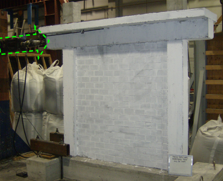J. Centeno1 C.E. Ventura2 S. Foo3and S. Brzev4
- MASc. Student, University. of British Columbia, Vancouver, BC, Canada centeno@civil.ubc.ca
- Professor, University. of British Columbia, Vancouver, BC, Canada ventura@civil.ubc.ca
- Risk management specialist Public Works and Government Services Canada simon.foo@pwgsc.gc.ca 4Professor, British Columbia Institute of Technology Brzev@bcit.ca
ABSTRACT
A large number of existing buildings, particularly those constructed prior to the enforcement of ductile seismic design provisions introduced in 1970’s, were primarily designed and detailed to resist gravity loads. In addition, the presence of masonry infill walls was often ignored in the structural design since they were normally considered as architectural elements. Lessons learned from past earthquakes have shown that there is an interaction between the masonry infill with the bounding frame when subjected to moderate to strong earthquake loads. Such interaction may or may not be beneficial to the structural performance, and has been a subject of many debates because of the brittle behavior of masonry and possible undesirable effects characteristic for seismic response of this system.
This paper presents the first part of an experimental testing program carried out at the University of British Columbia (UBC) in Vancouver, Canada testing the performance of 1/2 scale gravity load designed reinforced concrete frames with unreinforced concrete block masonry walls. The first part of this testing program consisted of one monotonic loading test on an infilled frame and two series of shake table tests, one on an infilled frame and one on a bare frame with the UBC Earthquake Engineering Research Facility (EERF) unidirectional shake table.
KEYWORDS: existing buildings, infill, lap splices
A8-4



